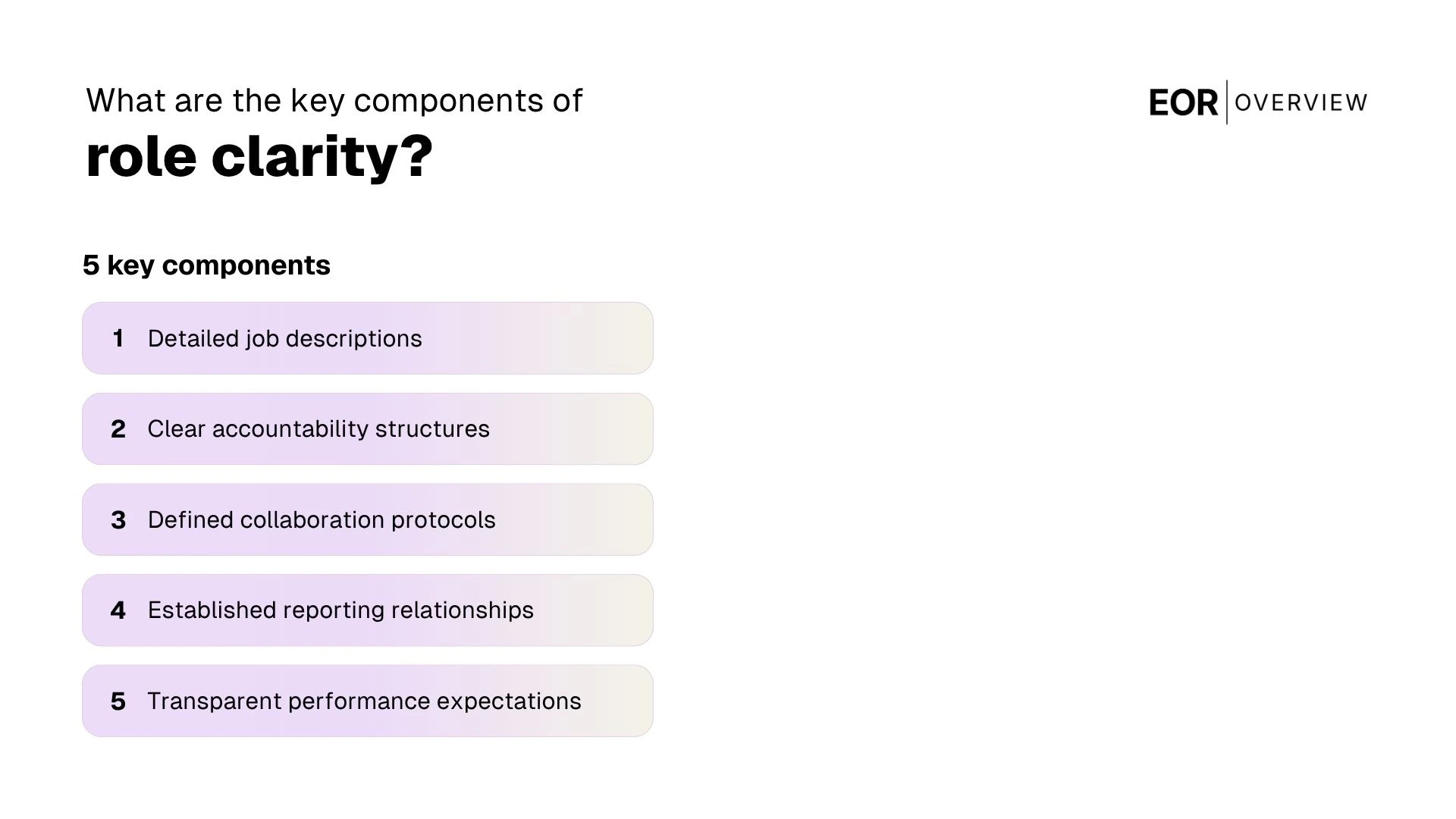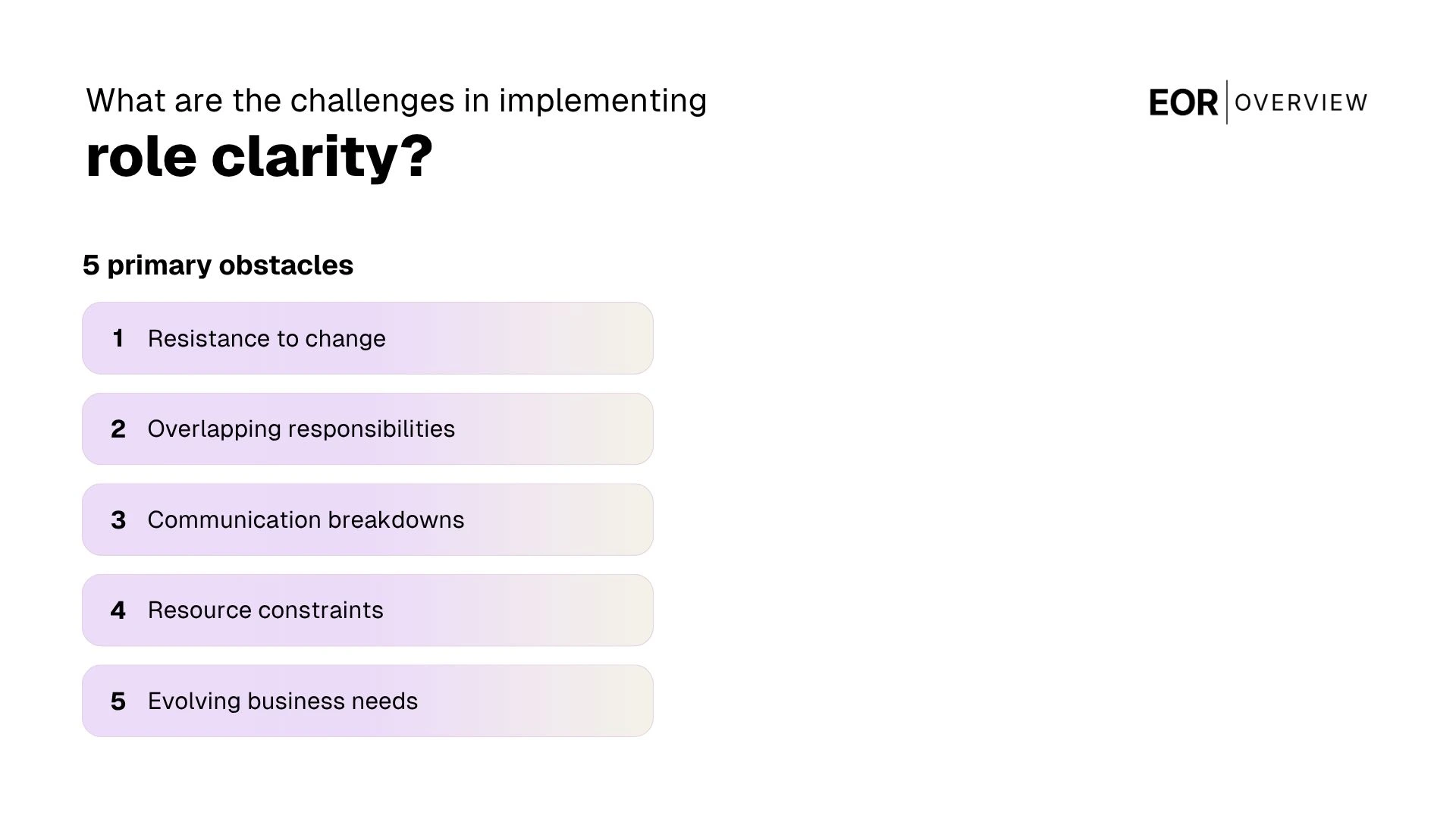Role clarity is a strategic framework that defines specific responsibilities, expectations, and boundaries for each position within an organization, ensuring every team member understands exactly what success looks like in their role.
In today's fast-paced tech and finance environments, role clarity has become the competitive advantage that separates high-performing teams from those stuck in endless cycles of miscommunication and missed opportunities. A clear role definition directly impacts employee engagement, reduces turnover costs, and accelerates project delivery timelines.
Organizations with well-defined roles experience significantly higher productivity levels and reduced workplace conflicts, making role clarity a critical investment for scaling startups and established companies alike.
What is role clarity?
Role clarity represents the precise understanding each team member has regarding their specific duties, decision-making authority, and expected outcomes within an organization. When employees understand their role expectations clearly, they can focus their energy on delivering results rather than navigating confusion about what they should be doing.
Achieving role clarity requires more than just writing job descriptions. It involves creating transparent communication channels where roles and responsibilities are defined, discussed, and refined based on ongoing feedback from both managers and team members. This clarity becomes especially critical in fast-paced environments like tech startups and finance organizations, where responsibilities can shift rapidly.
Organizations that improve role clarity see immediate benefits in productivity and employee satisfaction. Team members spend less time second-guessing their priorities and more time executing strategic initiatives. The ability to measure role effectiveness becomes straightforward when everyone understands their specific contributions to organizational goals and can track their progress against clear benchmarks.

What are the key components of role clarity?
Role clarity consists of five essential components that eliminate confusion and drive employee performance. These components include detailed job descriptions, clear accountability structures, defined collaboration protocols, established reporting relationships, and transparent performance expectations.
These components work together to create a comprehensive framework that guides team members through their daily responsibilities and long-term objectives.
Detailed job descriptions: Comprehensive documentation that outlines specific responsibilities, required skills, and expected outcomes for each position to prevent task overlap and reduce workplace conflict.
Clear accountability structures: Defined ownership for decisions, deliverables, and outcomes that establish who is responsible for what results within the organization.
Defined collaboration protocols: Established guidelines for how team members interact, share information, and coordinate efforts across departments and projects.
Established reporting relationships: Clear hierarchies that specify who reports to whom and how communication flows between different levels of the organization.
Transparent performance expectations: Specific metrics and standards that help employees understand how their success will be measured by their manager.
Implement a quarterly role clarity audit where managers review each team member's understanding of their responsibilities. This simple process catches misalignments before they impact productivity or create conflict.
What is the difference between roles and responsibilities?
Understanding the distinction between roles and responsibilities is crucial for creating clear roles that drive employee engagement and productivity. A role defines what an employee is within the organization, while responsibilities outline what they must accomplish in that position.
The main distinctions include definition scope, performance expectations, measurement approach, and communication requirements. These differences help employees know what is expected of them and create a foundation for success.
Role definition: Establishes the employee's position title, department placement, and overall function within the organizational structure to align with company objectives.
Responsibility scope: Details specific tasks, deliverables, and outcomes that the employee must complete to meet performance metrics and drive results.
Performance measurement: Roles provide context for evaluation, while responsibilities offer concrete criteria that HR teams can use to assess success and improve performance expectations.
Communication framework: Clear role boundaries enable open communication between team members, while defined responsibilities create accountability that enhances the overall work environment and employee satisfaction.
What is the importance of roles and responsibilities?
Role clarity is crucial for driving organizational success across tech, finance, and startup environments. When employees understand their roles and have a clear understanding of their roles, they can align their efforts directly with organizational goals and make informed decisions within their scope of authority.
The primary advantages include improved decision-making, enhanced ownership, reduced inefficiency, streamlined training and development, and better alignment with organizational goals. These benefits are listed in detail below.
Enhanced decision-making: Clear role definitions empower employees to make confident decisions within their authority, reducing bottlenecks and accelerating project timelines.
Increased ownership: When team members understand their specific responsibilities, they take greater accountability for outcomes and deliverables.
Reduced inefficiency: Well-defined roles eliminate duplication of efforts and ensure resources are allocated effectively across departments.
Targeted training and development: Clear role expectations enable HR managers to design precise skill development programs that address specific competency gaps.
Minimized confusion: Employees know exactly where to direct questions or concerns, creating smoother workflows and better communication channels.
What are the benefits of role clarity in an organization?
Role clarity delivers enhanced productivity, improved accountability, reduced conflicts, streamlined decision-making, and better teamwork within an organization. These benefits directly impact how teams assess performance, manage their scope of responsibilities, and work more efficiently toward shared objectives.
These benefits create a foundation for organizational success and are detailed below.
Enhanced productivity: Employees work more efficiently when they understand their specific responsibilities and can focus on task completion without confusion about priorities or boundaries.
Improved accountability: Clear role definitions make it easier to assess individual performance and hold team members responsible for their designated outcomes.
Reduced conflicts: When everyone understands their scope of work, territorial disputes and overlapping responsibilities diminish significantly.
Streamlined decision-making: Teams can make faster decisions when authority levels and decision-making responsibilities are clearly defined within an organization.
Better teamwork: Collaboration improves when team members know how their roles interconnect and support each other's objectives.

What are the challenges in implementing role clarity?
Implementing role clarity faces several obstacles that can undermine even well-defined positions. These challenges create gaps between expectations and reality, affecting team efficiency and employee motivation.
The primary obstacles include resistance to change, overlapping responsibilities, communication breakdowns, resource constraints, and evolving business needs. These challenges can prevent organizations from achieving better outcomes through clear role definition.
These implementation challenges are detailed below.
Resistance to change: Employees may resist new role definitions that alter their current responsibilities or interaction patterns with colleagues.
Overlapping responsibilities: Existing roles often have unclear boundaries, making it difficult to establish well-defined positions without creating gaps in coverage.
Communication breakdowns: Poor communication during implementation can prevent misunderstandings and create confusion about new expectations.
Resource constraints: Limited time for one-on-one meetings and training sessions can hinder proper role clarity implementation.
Evolving business needs: Rapidly changing priority requirements demand flexible role definitions that balance clarity with adaptability.
How can HR professionals ensure role clarity during the hiring process?
Establishing clear role expectations is a process that requires strategic planning and systematic implementation throughout your hiring workflow. HR professionals must create detailed job descriptions that outline specific responsibilities, performance metrics, and reporting structures to help employees understand their position from day one.
The most effective approaches include comprehensive job analysis, structured interview processes, transparent communication protocols, and detailed onboarding documentation. These strategies work together to create a foundation that will enhance team performance and reduce turnover.
Comprehensive job analysis: Collaborate with hiring managers to define core competencies, daily tasks, and success metrics before posting positions.
Structured interview framework: Design interview questions that help candidates make informed decisions about role fit and career alignment.
Transparent communication protocols: Establish clear channels for ongoing role discussions between managers and new hires during the first 90 days.
Detailed onboarding documentation: Create role-specific guides that outline expectations, processes, and team dynamics to accelerate integration.
What is the role of managers in maintaining role clarity?
Managers serve as the primary architects of role clarity within their teams, translating organizational objectives into actionable responsibilities. They bridge the gap between high-level company strategy and individual contributor expectations, ensuring each team member understands their specific contribution to business outcomes.
Managers must focus on defining expectations, providing regular feedback, facilitating cross-functional alignment, and adapting roles as business needs evolve.
These responsibilities are detailed below:
Defining expectations: Managers create detailed job descriptions and communicate specific performance metrics that align with both team goals and individual career development paths.
Providing regular feedback: Through consistent one-on-ones and performance reviews, managers clarify role boundaries and address any confusion before it impacts productivity.
Facilitating cross-functional alignment: Managers coordinate with other department heads to ensure their team's roles complement rather than overlap with other functions, particularly important in fast-growing tech and finance organizations.
Adapting roles as business needs evolve: Effective managers proactively adjust role definitions as market conditions change, ensuring their teams remain agile and relevant.
How to improve role clarity?
The most effective approaches include conducting comprehensive role audits, creating detailed job descriptions, establishing clear reporting structures, implementing regular check-ins, and providing ongoing feedback mechanisms. These strategies are listed in detail below.
Comprehensive role audits: Review existing positions to identify overlapping responsibilities and gaps in accountability that create confusion.
Detailed job descriptions: Develop specific, measurable job descriptions that outline core responsibilities, decision-making authority, and success metrics.
Clear reporting structures: Establish transparent organizational charts that define who reports to whom and how teams interact across departments.
Regular check-ins: Schedule consistent one-on-one meetings to discuss role expectations, address questions, and clarify evolving responsibilities.
Ongoing feedback mechanisms: Create systems for continuous dialogue about role performance and adjustment of responsibilities as business needs change.
Avoid creating role descriptions that are too broad or vague. Generic phrases like 'other duties as assigned' can undermine the entire clarity effort and leave employees uncertain about their true priorities.

